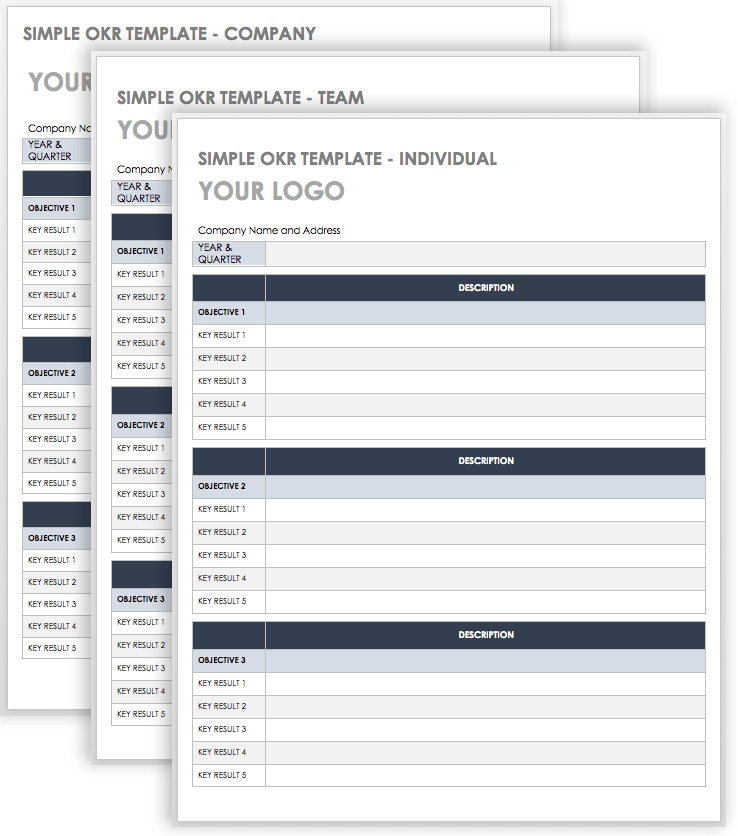What Is an OKR?
OKRs, or objectives and key results, are a tool for defining and tracking goals and outcomes. Company leadership uses OKRs to share visionary goals with the whole organization. Teams then create their goals to contribute to these high-level objectives.
An OKR includes an ambitious, generalized objective and three to five specific, measurable key results. People or teams use the key results to determine when they’ve achieved an objective. OKRs have deadlines, but teams and companies may continue to aim for key results after the cutoff date.
Optimally, a company, team, or individual should have one to five objectives. Fewer OKRs are better since the goal is to help teams focus on critical aims. In resource-limited environments, OKRs clarify what work to prioritize. The method helps eliminate busywork to make space for efforts that produce lasting change and value.
Companies can use OKRs to align strategic aims. Through regular reviews and scoring, OKRs add accountability and tracking to ensure goals don’t get lost in the distractions of daily work. OKRs can also help transform teams by stretching their creativity and capabilities.
Companies as diverse as Twitter, The Guardian newspaper, ING Bank, Airbnb, startups, and technology firms use OKRs. One reason is that it’s easy to quickly pivot OKRs to meet new challenges.
“OKRs are a faster and more agile way to adapt your business strategy to changing circumstances,” says Dan Montgomery, Founder and Managing Director of Agile Strategies and author of Start Less Finish More: Building Strategic Agility with OKRs.
They are also a tool for a changing work world.
“As millennials gain power in the workforce, OKRs will become a tool they use to drive accountability and innovation. OKR leadership is also emerging as the dominant decision-making process for remote workers,” says Doug Gray, CEO of Action Learning Associates, LLC and the author of Objectives + Key Results (OKR) Leadership: How to Apply Silicon Valley's Secret Sauce to Your Career, Team or Organization.
OKR Terminology
OKR terminology stands for objectives and key results. Related terms include alignment, which describes how staff orient to strategic goals, and engagement, which relates to staff commitment to goals. Cadence refers to how frequently teams set, grade, and work OKRs.
What Are Objectives in an OKR?
An objective is a clearly defined, qualitative goal. Objectives are short, inspirational, and engaging. They are aligned throughout the organization, create major change or progress, and can be time-bound.
An objective should stretch teams and individuals beyond what they think they can accomplish and not just set easy goals to ensure a performance bonus. An example of an objective:
Create a salt-caramel version of our popular chocolate bar.
What Are Key Results in an OKR?
Key results are metrics, targets, and milestones that measure progress toward an objective. They should be specific, measurable, and time-bound, and they contribute to the objective. An important distinction is that they describe outcomes, not activities.
A key result example:
New salt-caramel chocolate bar available in 30 bakeries and candy stores along the West Coast in Q2.
For more guidance on what OKRs look like, see the extensive list of OKR examples and samples.
What Are Initiatives?
Initiatives represent the tasks and activities that bring key results to fruition. Initiatives are clearly defined efforts that team members can manage without outside help.
To create initiatives, consider how to contribute to a set of key results and their objective. You can have as many initiatives as necessary. Detailed initiatives can form a type of plan for the quarter. However, management at any level shouldn’t create initiative lists — doing so could take agency and ownership away from the people who know how to perform the tasks.
Example of an initiative:
Research top 50 wholesalers, cruise ship provisioners, and large bakeries and candy stores in California, Oregon, Washington, and British Columbia.
Follow these best practices for initiatives:
- Assign an owner to an initiative, whether a team or an individual.
- Redefine initiatives as circumstances change.
- Ensure your initiatives are specific, measurable, and controllable.
- Keep a list of initiatives or tasks so that you can track progress.
OKR Process and Methodology
The OKR process is also called the OKR methodology. The OKR process sets goals and aligns efforts throughout a company. The process encourages a focus on meaningful change. Regular progress reviews keep OKRs a priority each workday.
Although the OKR process is straightforward, following certain steps guarantees a more productive experience.
- Understand the Hierarchy of OKRs: You can decide which OKRs to pick when you understand the hierarchy: the company mission inspires overarching objectives and key results. Teams use that information to create OKRs that contribute to company goals and set initiatives to complete key results.
- Understand Cadence: Cadence is the period for working on OKRs. Company objectives are in yearly cycles. Teams and departments usually have quarterly OKRs.
- Create OKRs: Come together as a team to develop OKRs. See our article on how to write OKRs for details about selecting objectives and key results, aligning goals throughout the company, and more.
- Agree on a Scoring Method: A key part of creating OKRs is setting a scoring scale for determining success. Our OKR scoring guide offers more details on how to put this into practice.
- Communicate OKRs to Everyone: Transparency is a strength of the OKR method. Publish team and even individual OKRs. Use your intranet, a dedicated OKR tracking tool, or even a flip chart or whiteboard for a small team. However, OKRs that concern personnel or strategic moves should be kept confidential from competitors.
- Review and Update Progress: As people work on OKRs, they should update their status. Regular reviews and interim scoring not only keep goals on the front burner; they also alert managers and coworkers to potential blockers and struggles.
- Don’t Despair for Low Grades: View low grades as data to help refine OKRs for the next quarter. This advice is especially true for aspirational goals.
- Consider the Google Scoring Approach: In the Google OKR scoring method, an OKR is good when it receives a score of 70-75 percent. A score of 100 percent is excellent.
OKR Best Practices
OKRs help companies, teams, and individuals set goals and measure progress. OKRs focus attention on priorities. Frequent review and grading sessions keep goals top-of-mind and help every employee understand how their efforts contribute to company growth.
These best practices help promote OKR adoption and engagement so that they become an effective tool for cultural change.
- Expect Opposition: Some people receive new improvement and management systems with cynicism. Often they’ve observed previous efforts that were ill supported or fruitless, or they view such initiatives as more work. Be patient with staff when implementing OKRs.
- OKRs Shouldn’t Hurt:
- According to Christina Wodtke, speaker and author of the OKR-based book Radical Focus and her recent title, The Team that Managed Itself, OKRs shouldn’t cause pain from overexertion. “They should be like a yoga stretch, where you go a little further each time.”
- Do What Feels Right: Don’t feel you have to copy the approach that other companies use. Run an OKR effort in a way that works best for your organization.
- Start Small: Don’t roll out OKRs to the whole company simultaneously. As in the practice of the Plan-Do-Study-Act (PDSA) cycle and continuous improvement, start in one department and fine-tune the process. Read our article on continuous improvement for ideas on making small changes and adding initiatives incrementally to achieve a cultural transformation.
- Use Tools in Your Comfort Zone: Track your OKRs using a spreadsheet, a document, or a white board. Don’t spend a bundle on a software package before you try the OKR framework.
- Create Only Three to Five Objectives, with Only Three to Five Key Results: Pick a few objectives that can transform your business in a quarter. Similarly, add only the essential key results. Too many of both could cause an organization to potentially spend more time tracking goals than working on projects.
- Consider Measurable Key Results: Select key results that are measurable because they reveal how you will achieve an objective. However, some practitioners believe that qualitative key results are okay.
- Assign Key Result Owners: Designate one person to track and report on the progress of key results.
- Be Ambitious: Aspirational OKRs encourage people to take risks without fear that it will affect their performance bonus if they fail. If you’re certain you can meet a key result, extend expectations a little further. OKRs should feel slightly scary.
- Align Team OKRs with Company Strategy: Team OKRs provide vehicles to communicate strategy and goals throughout the company.
- “Company and team goals both must be in alignment on what's important, and when there's no alignment, focus, or communication, it's going to lead to bad decisions,” stresses Darrel Whiteley, a Master Black Belt, Lean Master, and Kaizen expert with Firefly Consulting. “It sounds obvious, but you must communicate priorities. There can be no doubt about what's important to the company between the chief executive officer and the guy on the line that's opening a valve to fill up a tank.”
- Put the Customer First: A business can grow by offering a unique value proposition to customers. Write OKRs that answer customer questions and needs.
- Review OKRs Regularly: Be flexible. If your company, team, or personal goals change, feel free to change the OKRs. No process should be more important than common sense and everyday business. Especially in volatile industries and companies, priorities change fast. Make sure your goals reflect new priorities.
- Keep Key Results Positive: Instead of saying, “Reduce support calls by 15 percent,” present it as “85 percent of customers have a positive experience.”
- OKRs Are Not the Be-All and End-All: Wodtke cautions that OKRs are not the whole story. They are one tool in your box. “You still have to do the messy work of managing people and having difficult conversations.”
Simple OKR Template
Download Simple OKR Template
Microsoft Excel | Microsoft Word | Smartsheet
Use this basic template as a guide to start sketching your OKRs. Delete sections you don’t need, or add new ones as your requirements change. This template makes it easy for small teams or OKR novices to explore the methodology.
You’ll find more useful free, downloadable templates to help you plan OKRs and reach long-term goals, in our OKR template article.
OKR History
The use of OKRs go back to Peter Drucker’s Management by Objectives (MBOs). Andy Grove, the co-founder and former CEO of Intel, used MBOs as the foundation for his management methodology, which he originally called Intel Management by Objectives (iMBO).
Grove’s adaptations of MBOs included bottom-up rather than top-down alignment of goals, quarterly OKR cycles and reviews rather than annual cycles, and decoupling OKRs from compensation.
Future venture capitalist John Doerr learned to use OKRs at Intel. He developed the formula:
I will (objective) as measured by (key results).
You can learn more about writing OKRs in our how-to guide.
In 1999, Doerr inspired the most famous — and arguably most successful — OKR application when he taught the formula to the startup Google. The company co-founder and Alphabet CEO Larry Page has since credited OKRs with producing “10x growth, many times over” as the company expanded from 40 employees to more than 60,000.
Some business experts say that OKRs are the way forward for millenials and others because the approach provides agency to employees. “A number of researchers have latched onto other words to describe what OKRs offer: they accelerate accountability, transparency, alignment, and focus,” explains Doug Gray. “But agency is the word that I've added. The top-down hierarchical structures of organizations typically don't work as well.” In essence, OKRs let people find their own way to work toward a common goal.
Benefits of OKRs
The benefits of OKRs include providing better strategic alignment and focused execution by keeping everyone on the same page. Engaged employees can use OKRs to expedite a cultural shift.
According to Wodtke, “Even when people do OKRs wrong, people still get benefits. Adjust them to your culture and do them the way you see fit.”
Additional OKR Benefits
In addition to team and individual alignment and execution, OKRs provide more benefits at all levels of an organization:
- Employees want to feel a higher purpose. If the company can articulate a vision, OKRs help employees see and manifest it. Staff aren’t just producing widgets; they know why they're doing what they’re doing, and they have some control.
- Delegates control to the lowest level of the hierarchy to do what needs to get done. “Eyes-on, hands-off leadership,” shares Gray.
- OKRs are about value and impact, which is not the same as keeping busy while working toward an individual performance review.
- OKRs are a simple tool to implement. It takes just a few hours each quarter to check and review them.
- A fast-cadence, or work period, process engages each team’s perspective and creativity. Wodtke adds, “It’s the cadence and the check-in that wins this every time. You can use smart goals. You can use KPIs. You can use OKRs. But the weekly review and the quarterly review remind people of what needs to get done and pushes things along. You can see results and discuss progress regularly.” Read our articles to learn more about the differences between OKRs and KPIs and OKRs and smart goals.
- Activity doesn’t always equal productivity. OKRs helps a company become results-driven as opposed to task-driven.
- If priorities suddenly change, you can easily adapt OKRs to reflect new developments.
OKRs as Communication Framework
As a communication framework, OKRs provide clear objectives and measurable key results that everyone can understand. You spend less time iterating direction and more time in problem solving and creative work. People are more likely to be engaged and productive.
OKR management and tracking happens through tools as simple as pen and paper or with dedicated OKR software. Follow-up happens in weekly and midterm meetings. “Communicate through weekly meetings that focus not on firefighting but on OKRs,” advisess Whiteley. “Also, consider a dashboard, so everyone can see success in real time. Gauges, thermostats to watch sales dollars increment, that’s powerful stuff.”
What’s Unique About Sharing OKRs?
OKRs are akin to agile goals in that they can be ambitious and provide a “north star” and elevated vision. Stakeholders throughout the hierarchy align their own objectives, providing influence on goals from the bottom up.
OKRs also emphasize transparency. Organizations should publish every OKR, from the line-worker’s to the CEO’s. Sharing this information can foster cooperation that might not occur when teams work in silos. “We don’t consider how much our success is tied to the team’s performance,” muses Gray. “So much drivel is written about the charismatic leader. Charisma has nothing to do with it. Success comes from the team. OKRs visualize that.”
But OKRs can be a powerful tool for individuals, too. “People don’t think of the many teams in their lives that influence their chances of success,” Gray says. “You can think of publishing OKRs as a way to map which people around you can most influence your career. Creating and publishing OKRs provides a method for others to find ways to help you and vice versa.”
OKR Management
OKR management is a framework for setting company-wide goals. OKRs provide companies a measurable means to convey their vision throughout the hierarchy. The OKR framework helps teams focus on outcomes and not just activities.
Okay and Not Okay OKRs
In the world of business and innovation, schemes don’t always work out. When they do, the results can be spectacular. We imagined how the OKRs might have looked for a few of the great inventions and failures.
Success Stories
ThighMaster: a Firm Success
Before the exercise infomercials of Billy Blanks and Tae Bo, before Tony Horton and PX90, there was Suzanne Somers and the ThighMaster. As an actress, Somers rose to fame in the 1970s U.S. TV show, Three’s Company. But many know her today as the host of the 1990s ThighMaster infomercials. A simple in-home exercise device, the ThighMaster works like a giant grip builder. Its developer originally called it the V-master and targeted it to the upper body. Somers says it was she who saw the potential for exercising legs. Through infomercials in the pre-ecommerce era, the device quickly garnered millions of dollars for Somers and the company. Thirty years later, the ThighMaster continues to sell without the infomercial or even endorsements by fitness professionals.
- Objective: Become the most popular home fitness device in the United States.
- Key Result 1: Sell 250,000 units in our first quarter.
- Key Result 2: Infomercial returns a gross profit margin of 52 percent across all U.S. markets.
- Key Result 3: Achieve a customer loyalty index (CLI) of 8 or higher.
Tesla 3: A Story of Handmade Delays
As outsiders, we can’t know exactly what happened to make Tesla start construction on the Tesla 3 before its automated production line machinery was complete. Story has it that factory employees hand-fit and finished many parts, which caused output to lag.
- Objective: Start production of Tesla 3 despite not having a fully automated body line.
- Key Result 1: Rearrange work stations to accommodate new tools.
- Key Result 2: Each line worker produces two QA-approved handmade units a week by the end of the first month.
- Key Result 3: Design and distribute commemorative Tesla 3 T-shirts to the entire team.
SpaceX Rockets to Success
While the Tesla 3 may have had its delays, another company has experienced some spectacular — stratosphere-breaking — achievements. The SpaceX mission is “To revolutionize space technology and send people to Mars.” A giant step toward enabling space travel is a returnable rocket, which SpaceX achieved with a first-stage rocket in 2015.
- Objective: Successfully launch and recover a returnable rocket.
- Key Result 1: Hire three fuel experts by the first quarter.
- Key Result 2: Complete and approve requirements by the third quarter.
- Key Result 3: Create a solid PR campaign for the project.
OKR Success Stories
For more than 40 years, companies in assorted industries and verticals have benefited from OKRs. They provide a structure for communicating the big-picture goal and creating a path to achieve it. These are a few OKR corporate success stories.
Intel
In 1979, Intel had a problem: rival Motorola produced an easy-to-use microprocessor. With Andy Grove using the OKR framework as Intel’s champion, the entire company realigned to a new strategy in a matter of weeks. By the end of 1980, Intel had become the leading microprocessor manufacturer. Its chips are in hundreds of millions of devices worldwide.
Here is an example of one OKR from the Intel scheme for chip leadership, Operation Crush:
Objective: Establish the 8086 as the highest-performance 16-bit microprocessor family.
- Key result #1: Applications: Develop and publish five benchmarks showing superior 8086 family performance.
- Key result #2: Marketing: Repackage the entire 8086 family of products.
- Key result #3: Engineering/Manufacturing: Get the 8Mhz part into production.
- Key result #4: Engineering: Sample the arithmetic coprocessor no later than June 15.
Google’s success from OKRs is perhaps one of the most famous examples.
Google used OKRs when developing the Chrome browser. To encourage the type of speed that would reflect a seamless web experience, Larry Page and Sergei Brin wrote the OKR: “We should make the web as fast as flipping through a magazine.” One of the resulting OKRs on the Chrome team was to make JavaScript run 10 times faster. With the help of the right engineer, Lars Bak, within two years JavaScript ran 20 times faster in Chrome.
Arc’teryx
The Canadian outdoor-wear company creates big-picture objectives that extend out for five years. Each department then creates goals to support those long-term objectives. For Arc’teryx, published goals produce focus and confidence. Transparent visible objectives also make it easier to identify common aims.
A common OKR worksheet affords one view for the whole company, which helps teams align efforts and cooperate. “One of the strongest points of OKRs is the alignment and the commitment,” says Tom Giannelli, Senior Manager, Business Solutions at Arc’teryx. “To have alignment, you have to have visibility. By having everything in one location — not multiple sheets, but one location — it’s very easy to align with the other departments on what they’re doing, on how you’re feeding up into their OKRs, and on what you’re doing that contributes to the rest of the organization.”
Provide a Transparent Platform for Tracking OKRs with Real-Time Work Management in Smartsheet
Empower your people to go above and beyond with a flexible platform designed to match the needs of your team — and adapt as those needs change.
The Smartsheet platform makes it easy to plan, capture, manage, and report on work from anywhere, helping your team be more effective and get more done. Report on key metrics and get real-time visibility into work as it happens with roll-up reports, dashboards, and automated workflows built to keep your team connected and informed.
When teams have clarity into the work getting done, there’s no telling how much more they can accomplish in the same amount of time. Try Smartsheet for free, today.




